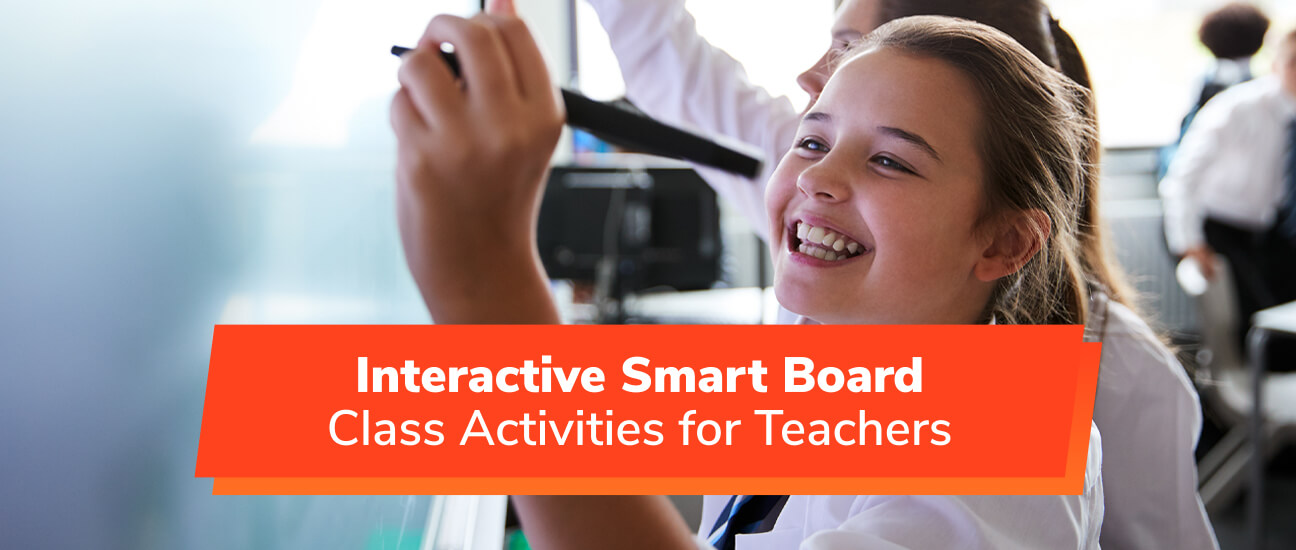Published on July 21st, 2021
Interactive whiteboard class activities for teachers
15 minute read

Teaching can be extremely difficult. Arming yourself and your teachers with the best possible tools to plan captivating lessons, deliver engaging classes and generally keep your students engaged is one of the simplest steps you can take to make it easier. An interactive whiteboard or smart panel is one of the best assets a teacher can have at their disposal. The opportunity these smart panels can unlock is endless, but that same opportunity can make things a little daunting.
With this in mind, and as experts in both educational software and interactive classroom technology, we’ve put together the ultimate guide on student activities for interactive smart panels and are here to help you find interactive class activities online.
The benefits of using interactive classroom activities
The benefits of technology in education are far reaching, and one of its biggest benefits is how it can enable interactive learning. Making your classroom interactive has a number of its own benefits too and many studies have been done that show the true benefit of interactive learning.
Not only do interactive classroom activities keep your students engaged, helping them not just stay awake but be involved, but they can help improve the learnings from a lesson and develop other important life skills.
These benefits allow teachers to be more effective in the classroom and out, and have been proven to help students of all ages and ability levels. Interactive lesson activities, like videos, quizzes, games, experiments or simulations can enhance a child’s ability to engage and learn.
We’re here to help you find a classroom activity for every age group, from early years all the way up to KS5.
Give early years students the best-possible start
The earliest stages of development are some of the most important. It’s also a time when learning focuses on visual elements and play. In short, it’s a stage that’s crying out for interactive learning.
Interactive activities for children of these ages may not be as rigid, and you are highly likely to spend time away from a whiteboard. You’ll want activities like:
Sensory play – at these early stages of development playing in sand pits and other sensory play experiences can help develop key senses. Helping them develop their touch, smell, tastes and sight. While the majority of these activities involve physical touch, an interactive whiteboard can be used to enhance play with sights or sounds.
Character play – role play, whether it’s a farmer with their tractor or a princess in their tower, is a great way to help children develop social skills and their own imagination. Allowing younger kids to think creatively can help with problem-solving down the line. Interactive whiteboards come with scenarios, videos and other interactive elements that can enhance role playing even further.
Interactive games – this is where your smart panel may come into play, whether you’re simply playing many of the games available directly through either the educational software on your smart panel or the internet, there are a whole host of games for younger children available. If you want some downtime from the screen too you could challenge your students to create their own games.
Other options for this age group include scavenger hunts, drawing, painting, music and dance. Anything that encourages play, creativity and discovery is ideal for younger children.
Interactive classroom games for KS1 students
Key Stage 1 is the period when you’ll lay the groundwork for what students will expect from school. Providing engaging lessons with interactive activities is key to holding their attention but also developing important skills they’ll use throughout their lives. Many of the interactive activities aimed at these age groups are games.
These games offer a chance to learn through play and many smart panel offer applications designed to run these games for a whole classroom.
Why not try:
Hangman – the classic spelling game can be used to help younger children learn simple words. Using a game app on an interactive whiteboard will allow children to play using trial and error, either right at the screen using touch or through a connected device.
Drag & drop games – using an interactive whiteboard, like the Promethean ActivPanel can improve students’ dexterity at the same time as learning. A drag and drop game, like caterpillar ordering, is a great option for this. Challenge students to use their hands to put strings of numbers in order, or arrange words into sentences.
Pictionary – another memorable childhood game, Pictionary lends itself incredibly well to an interactive whiteboard. Invite children up to the board and they can have fun drawing using smart pens or their own hands. Alternatively, a teacher can use the board to draw for them, having students guess as they draw.
Learning activities for KS2 students
Key Stage 2 is all about preparing children for secondary school. They’ll build foundations in important subjects like maths, science and english and more. The key here is to take the skills they’ve developed at KS1 and use those to help inspire them. Group work is an important part of KS2, and can be implemented through interactive whiteboards and displays.
A number of key learning options for KS2 include:
Quizzes – quiz-based learning is a great way to both test where your students are at, but also help them learn. You can run quizzes through your smart panel and allow students to answer verbally or through their own apps and devices. Quizzes can work for almost any subject and there are a number of specially designed quiz apps for smart panels, so you can add one to your lesson plan easily.
Guided reading – as your students reading abilities are improving, you may well want to run a number of guided reading sessions. Doing so in conjunction with a smart panel can allow you to annotate text as you go, record pupils queries and responses and allow them to collaborate with each other.
Scattergories – the much-loved family game lends itself incredibly well to interactive displays. It’s an excellent way to teach kids new words in a fun manner. You can use your interactive whiteboard to simply display the categories and a timer while kids play either using their own device or pen & paper, or you can encourage children to play using the board themselves.
Interactive games – a number of specialised games have been developed with children of this age group in mind. Why not try out the Science Museum’s ‘Total Darkness’ and get your students solving problems creatively.
Interactive teaching ideas for KS3 students
The first years of secondary school are an important time for many students. They may be exposed to a number of new subjects and experiences. It’s also a period where many children struggle with staying interested, and keeping them engaged with interactive classroom games or other activities can be important.
Videos – while playing video through your smart panels may be one of its most basic functions, adding videos to your lesson plans can be a great way to boost engagement. Rather than simply playing a video and letting it teach for you, you can use them to hit home important points during your lesson. The beauty of a smart panel is that you can annotate videos as they go, or draw over them if you need to. Use video to help tell a story.
Science experiments – not every class has access to the facilities to create real world science experiments. Many also don’t have the option to do so safely. There are a number of science specific smart panel tools that let you run experiments right there on the display. They’ll let you change settings and customise the experiment so it can simulate a number of variables. Whether you want to demonstrate static electricity by bending water or something a little more complex, you can do it without worrying about resources.
Annotate scientific diagrams – a number of apps and tools let you choose diagrams. These include things as complex as the human body, or as simple as a basic circuit for turning on an LED using a switch. Accessing these diagrams can allow students to create their own or else annotate key aspects of existing diagrams.
Enhance student learning in KS4
These years are about significantly more than just learning to pass exams. It’s when students can choose to take a subject they love even further. Giving students access to interactive learning and keeping lessons both exciting and enjoyable can inspire them to take it even further. A number of ways you could do this include:
Word games as an ice breaker – get the mind whirring and ready for other aspects of your lesson. Kick off with a word game, like Boggle or Scattergories, to wake up your students and get them thinking creatively.
Quizzes – creating quizzes for key aspects of your learning can help reinforce important parts of a lesson. You could consider finishing each lesson with a quick interactive quiz that recaps the important takeaways from today’s class.
Role play – help students build confidence in drama or simply immerse them in important characters or scenes in english lessons. Role playing, with multiple interactive elements can help students with all of this. Using a ‘choose your own adventure’ method allows students to really make a character their own, or get inside the head of important characters from the books you’re reading.
Drive student engagement in KS5 with online classroom activities
By this point the students in your classrooms will have chosen their own subjects, and their participation should be easier to garner, but it’s still important to keep them engaged. Many people learn through doing, and interactive lessons can really help students understand important aspects that they just can’t get from course readings.
Try things like:
Quizzes – test your classes’ knowledge and ask students to either create the quizzes themselves for groups or answer a series of tough questions that you’ve put together. Creating leaderboards and allowing students to answer questions from their own devices will keep things competitive too.
Video – using your interactive whiteboard to showcase important concepts through video or a particular case study can greatly enhance the learning experience. Letting a class draw, annotate or take notes directly on the video can add even more.
Experiments – showcasing experiments from other labs, or using an experiment tool to simulate one you can’t do in your own classroom can add a whole new dimension. See this as a classroom game for slightly older students. Allow them to customise variables themselves and see what happens.
Annotations & diagrams – You can annotate scientific diagrams yourself, or you can let your students come up to the front of the class and add their own annotations.
Get the most out of your class with interactive whiteboards and software
Whatever way you want to teach your students, keeping them involved in the process is important. When your students come to a classroom and feel like an active participant, it’s only going to help. Promethean creates world leading interactive whiteboards designed with the classroom in mind. Not only that, but we set the standard on educational software to help you get the most out of your smart technology.
Interested in learning more? Visit the virtual demo page to request a live demo of the Promethean ActivPanel interactive display.
If you have enjoyed this guide, why not check out some of our other expert interactive whiteboard resources




